It’s important to keep your baby’s toys clean and germ-free to help protect their health.
Toys that are frequently played with should be cleaned once a week, and toys should be given a thorough cleaning or disinfecting after a playdate or if your child becomes sick.
In addition to cleaning toys regularly, be sure to wash your hands frequently to reduce the spread of bacteria and viruses. Let’s take a look at how to disinfect baby toys after illness.
Keeping baby toys clean
As a parent, you realise pretty quickly that anything your baby can get hold of is likely to end up in their mouth. Your clothing, car keys and fingers are just as likely to go in their mouths as their favourite toys. Therefore it’s really important to learn how to clean baby toys.
I distinctly remember having to have a word with myself at my first baby group while my little man was chewing anything and everything he could reach, regardless of whether it was covered in another child’s saliva or not.
The fact is you can’t sanitise everything they come into contact with, and neither should you. But, that said, once you have kids cleaning toys will become part of your routine. It’s important that you clean baby toys regularly, paying special attention after your little one has had a flu or tummy bug.
Different toys should be cleaned in different ways. And it’s a good idea to disinfect baby toys after illness to prevent the spread of nasty bacteria and viruses.
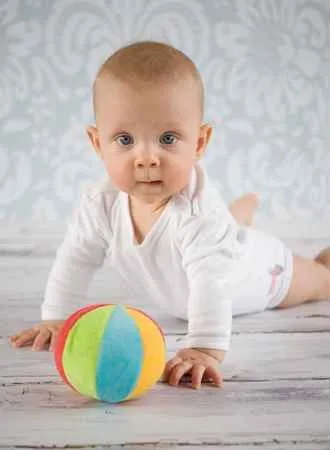
Cleaning wooden toys
Cleaning wooden toys is easier than you might imagine. Although wood is porous, meaning you can’t soak it in hot soapy water or chuck it in the dishwasher, it is also naturally antibacterial, meaning germs are less likely to breed and spread.
To clean toys first get rid of any dried-on food or other obvious dirt with a brush. Next, either wipe with warm soapy water or spray with diluted white vinegar and wipe with a damp cloth.
Vinegar is good as it acts as a disinfectant so will kill germs without being harmful to babies. Then air dry, in the sun if you can, although be careful not to leave in the sun for too long. Clean baby toys regularly but ensure to thoroughly dry each time.
Cleaning hard plastic toys
Plastic toys might seem like they are easier to clean but they often contain batteries and or lots of small nooks and crannies which makes cleaning more difficult and makes it hard to sanitize , therefore sometimes you need to take a little extra time to clean plastic toys.
Many toys that are made 100% from plastic, such as the fabulous Green Toys range made from recycled milk cartons, can simply be put in the dishwasher if you have one or washed in hot soapy water. An old toothbrush or a straw brush is a handy tool to help you clean any tricky bits.
Any electrical toys, either plug-in or battery-operated obviously can’t be submerged or put through the dishwasher. In this case clean in the same way you would wooden toys using a damp cloth.
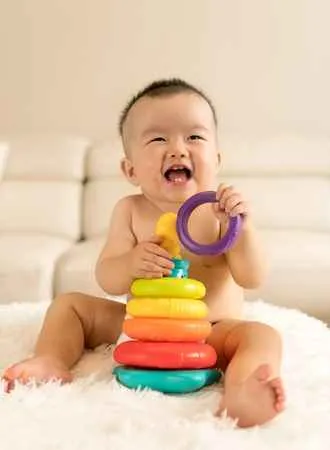
Cleaning soft or plush baby toys
Soft absorbent toys are great at sucking up food, saliva and other bodily fluids so they’re going to need a clean every now and again, no matter how hard it is to prise them away.
Fabric can be spot cleaned with a damp cloth to get the worst off, and most kids’ cuddly toys can go in the washing machine (check the label) providing they don’t have batteries.
Sunlight is also a fabulous disinfectant and great at getting rid of stains. And the heat from the tumble dryer will help kill bugs when the sun isn’t shining.
If you have many plush toys its a good idea to vacuum them frequently to remove the dust mites before putting them on a gentle cycle with mild soap in warm water. Your child’s toys can harbor nasty germs even if you can’t see any visible dirt. Smaller children’s toys can be put in a mesh bag and if you want to disinfect you can put them on a sanitizing cycle.
Some toys may not be able to withstand the heat or agitation of a washing machine, and may need to be cleaned by hand.
Rubber Toys
Here are a few tips on how to clean rubber toys:
- A good old-fashioned wash with hot water and soap is always a great place to start. Fill up a sink or basin with hot water and add a squirt of dish soap. Submerge the rubber toys and use a sponge or brush to scrub them clean. Rinse thoroughly and let them air dry.
- If you want to take it up a notch, a diluted bleach solution can be an effective way to disinfect rubber toys. Mix 1 teaspoon of bleach with 5 liters of water and soak the toys in the solution for a few minutes. Rinse thoroughly and let them air dry.
- For a natural disinfectant, try a mix of white vinegar and water. Just mix equal parts in a spray bottle and spritz it on the rubber toys. Let it sit for 15 minutes before wiping it off with a clean, damp cloth. Rinse thoroughly and let them air dry.
Doing this regularly will keep baby’s toys clean and baby healthy!
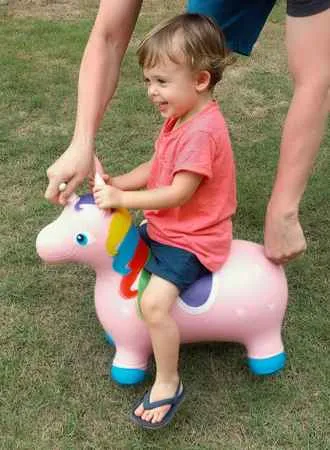
How to Disinfect Baby Toys After Illness
Generally, a wipe-down with a damp cloth is enough to clean baby toys.
However, if they get sick, or have a playdate with a poorly friend then you might want to clean baby toys a bit more thoroughly, especially any they have been sick on or have been in their mouths.
And of course, it goes without saying that if you or your child is sick you should be extra vigilant when it comes to hand washing as this will massively reduce the risk of germs spreading.
The difference between cleaning and disinfecting
Cleaning physically removes dirt and germs, whereas disinfecting kills them and stops them in their tracks. It is always important to clean before you disinfect to ensure toys are germ-free.
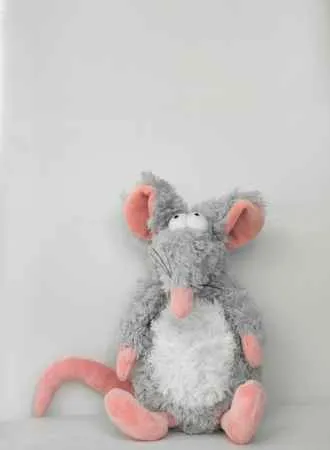
The best ways to disinfect baby toys
As with general cleaning, how you clean baby toys will depend on what the toy is made of, and how big they are. There are different rules when it comes to cleaning wooden baby toys compared to plastic baby toys.
If toys can go in the dishwasher this makes washing toys easy as most dishwashing detergent will contain a disinfectant. Otherwise, you will need to clean the surface of the toys with something that will kill any germs.
If you have a baby then the chances are you have some Milton in the house. As well as sterilising bottles and dummies you can also use Milton to sterilise toys. For toys that can be submerged make up a solution and give them a soak. Remove toys, rinse and allow them to dry.
Milton can also be sprayed onto toys that can’t be submerged and wiped off. Make sure you read the instructions and leave on for long enough to ensure disinfection takes place.
Alternatively, diluted bleach can also be used to disinfect toys. A teaspoon of bleach in 5 litres of water is strong enough to kill germs yet still be safe for your child.
If you have soft toys (stuffed animals, plus toys or any soft toys) that need disinfecting check to see if they can go in the washing machine. Most can on a wool cycle. A cool cycle is less likely to damage toys but isn’t much good if you are trying to sterilise so add a bit of laundry sanitiser to make sure you get rid of any nasties.
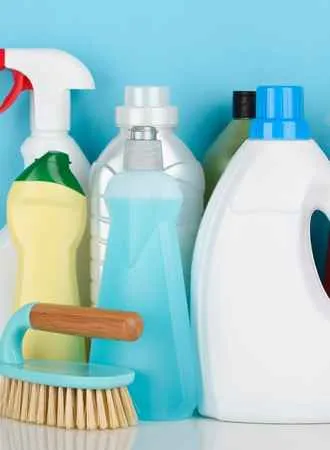
How to Clean Baby Bath Toys
There are a few different methods you can use to clean and disinfect bath toys:
- To clean bath toys wash with hot water and soap: Fill a sink or basin with hot water and add a small amount of dish soap. Submerge the bath toys in the water and use a sponge or brush to scrub them clean. Rinse the toys thoroughly and let them air dry.
- Use a diluted bleach solution: Mix 1 teaspoon of bleach with 5 liters of water. Soak the bath toys in the solution for a few minutes, then rinse them thoroughly and let them air dry.
- Use white vinegar and water: Mix equal parts white vinegar and water in a spray bottle. Spray the solution on the bath toys and let it sit for 15 minutes before wiping it off with a clean, damp cloth. Rinse the toys thoroughly and let them air dry.
- Use Milton: Milton is a disinfectant solution that can be used to sterilize toys. Simply make a solution according to the instructions on the bottle and soak the bath toys in it for the recommended amount of time. Rinse the toys thoroughly and let them air dry.
It’s important to follow the instructions on any cleaning or disinfecting products you use, and to be sure to rinse the toys thoroughly after disinfecting to remove any residue. Let the toys air dry before giving them back to your child to play with.

Disinfecting toys without chemicals
If you are wary of using harsh chemicals on kids toys you’ll be pleased to know that a 50/50 mix of white vinegar and water does the job just as well. This can be used on wooden toys, plastic toys and to soak bath toys.
For non-porous toys spray on and leave for 15 minutes, then wipe with a clean damp cloth and let dry.
For wooden toys apply the vinegar solution with a clean cloth, leave for a couple of minutes and wipe off with another damp cloth then let air dry.

How To Safely Disinfect Baby Toys Without Bleach
To safely disinfect baby toys without bleach, follow these steps:
- Gather Materials: You’ll need mild dish soap, warm water, a clean cloth or sponge, and a soft brush for textured toys.
- Remove Batteries: If the toy has batteries, remove them before cleaning.
- Soap and Water: Mix a solution of warm water and a few drops of mild dish soap. Use this to clean the toys thoroughly, using the cloth or sponge for larger surfaces and the brush for textured areas.
- Rinse: Rinse the toys with clean water to remove any soap residue.
- Air Dry: Let the toys air dry completely. This helps remove any remaining germs and prevents moisture buildup, which can encourage mold growth.
- Spot Cleaning: For stubborn spots or stains, you can use a mixture of water and white vinegar in equal parts. Apply this with a cloth, let it sit for a few minutes, and then rinse and dry.
- Regular Cleaning: Make a habit of regularly cleaning your baby’s toys to maintain a hygienic environment.
This method effectively disinfects baby toys without the use of bleach, which can be harsh and potentially harmful to infants.
How to Disinfect Toys With Vinegar
To disinfect toys with vinegar:
- Create a solution by mixing equal parts of white vinegar and water. Dampen a clean cloth or sponge with this solution and wipe down the toys thoroughly. Allow the vinegar solution to sit on the toys for a few minutes to effectively disinfect them.
- Rinse the toys with clean water to remove any vinegar residue.
- Let the toys air dry completely.
Vinegar’s natural acidity helps kill germs, making it a safe and eco-friendly option for disinfecting toys.
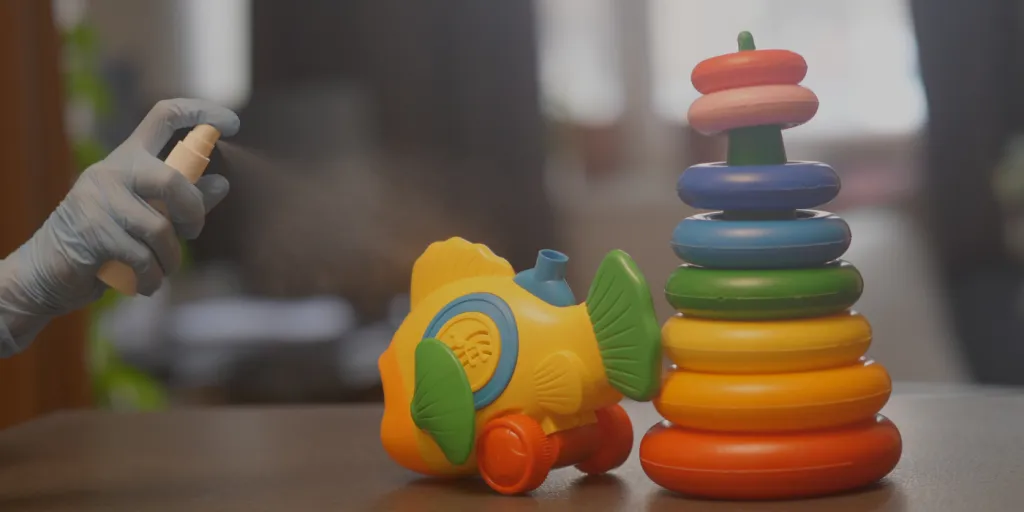
How To Disinfect Toddlers Toys After Having the Flu
To disinfect toddler toys after a bout of the flu, follow these steps:
- Clean Visible Debris: Wipe off any visible debris or mucus from the toys with a disposable tissue or cloth.
- Prepare a Disinfecting Solution: Mix a solution of 1 part white vinegar to 1 part water or use a 70% isopropyl alcohol solution in a spray bottle.
- Wipe or Spray: Dampen a cloth or use the spray to thoroughly clean and disinfect the toys, ensuring you cover all surfaces.
- Allow to Air Dry: Let the toys air dry completely to ensure all germs are killed and no chemical residue remains.
- Wash Hands: After handling the toys and cleaning materials, wash your hands thoroughly with soap and water.
Regularly disinfecting toys and practicing good hygiene can help prevent the spread of illnesses in your household.




